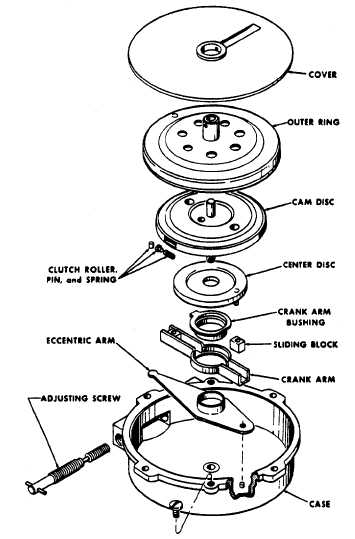|
| |
FIG. 16. CLUTCH TYPE CALIBRATOR.
For the purpose of adjustment, A.O. Smith meters are
equipped with a calibrator. Calibrators are of two
designs, the Clutch Type and the type G or Gear Type.
CLUTCH TYPE
The clutch type calibrator, Figure 16, utilizes two
overriding clutches and an eccentric. By adjusting the
amount of eccentricity the calibrator can be made to
vary any drive ratio between the meter and the register
by a maximum total of 11 percent.
This calibrating means is used for adjusting for
variations
in
operating
conditions,
differences
in
viscosity of product metered, as well as for providing
automatic temperature compensation.
OPERATION
The nature of the device is such that a correction
impulse is imparted to the calibrator output shaft once
during each revolution. This means that on a standard
Model "S" Meter which is geared to register 5 gallons for
each revolution of the calibrating or output shaft, there
will be one correction impulse for each five gal Ions. To
reduce wear to a minimum and to obtain maximum
accuracy in frequency of operation of the correction
device, the cycle has been reduced to one impulse per
barrel on the large capacity, continuous service meters,
hence a standard Model W, D or M-60 Meter which is
geared to one 42 gallon barrel per revolution of the
output shaft will have a correction cycle for each barrel.
Small capacity meters such as the Model T-10 Truck
Meters are geared one revolution per gallon and
consequently receive one correction impulse per gallon.
TEMPERATURE COMPENSATION
Temperature
compensation
is
accomplished
by
adjusting the amount of eccentricity of the calibrator
eccentric arm automatically by utilizing a thermostatic
bulb and bellows assembly ( see Figure 17).
The Smith meter accurately measures the actual
volume of the liquid passing through it, regardless of
temperature.
The Smith Temperature Compensator consists of a
thermostatic bulb connected by a capillary tube to a
metal sylphon bellows.
A9-28
|


